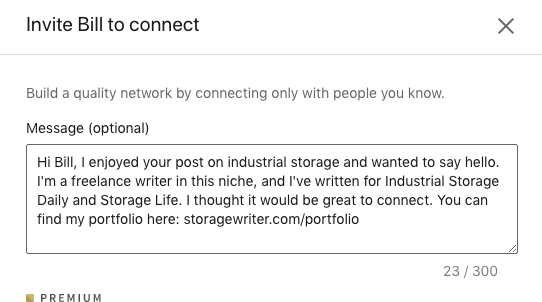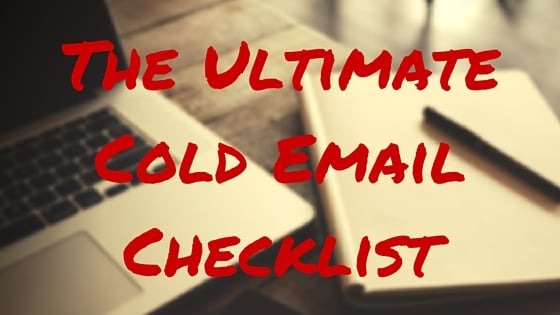You probably know about sending out cold pitch emails.
We’ve written a lot about how most people suck at sending out cold emails — especially pitches.
If you don’t want to be one of those people, then you need to read this right now.
But there’s actually another way to approach cold emailing that might be a better option for some of you. And that’s sending out letters of introduction, or LOIs for short.
These are a bit more of a gentle way to get in an inbox but still make a good impression.
Sound good?
Cool, check out this video, and then keep reading, because we’re going to answer your questions about letters of introduction.
What is a Freelance Writing Letter of Introduction?
Back in the olden days, when you actually mailed stuff to people to say hello, you should hire me, letters of introduction were pretty popular. They sort of formed what would be considered cover letters if you were sending out a resume.
Today, we don’t need to get too formal on that fancy resume paper, and we can look at LOIs as a quick note or email that introduces you and gives an overview of your freelance writing skills.
That’s it, pretty simple.
Letters of introduction are a great way to say “Hello, here I am” in a non-salesy or spammy way. And that’s good because inboxes like mine are filled daily with dozens of spammy emails demanding something from me.
Don’t do that.
Beyond email, LOIs are also really useful on a site like LinkedIn. (More on setting up your LinkedIn profile here).
LinkedIn allows you to send a small note when you want to connect with someone. You can introduce yourself, highlight your niche, and send a link to your portfolio (in about 300 characters).
Here’s an example in action:
How is an LOI Different from a Pitch?
Sometimes, people use these terms interchangeably, but they are different.
With a pitch, you’re typically asking for a job or an assignment. You’ll send pitches to a blog or site you want to write an article or a site to write a guest post.
With an LOI, you’re using your note or email to get yourself on the radar of the person you’re emailing. It could be a potential client, an agency, or even an editor. It’s not going in right away for the kill; it’s more about leaving the ball in their court, so to speak.
A good, and yes cheesy, way to think of the differences is like dating.
An LOI is saying, “Hey, I’m around for coffee sometime. If you’d like to go, let me know.” Whereas a pitch is more likely to say, “Hey, I’d like to get into a relationship with you; what do you think?”
See the difference?
Join over 40,000 people who have taken our 6 part freelance writing course. Sign up below and let’s do this together.
By entering your email address you agree to receive emails from Location Rebel. We'll respect your privacy and you can unsubscribe at any time.
Pitch vs LOI: When to Send
So, there are certain basic situations where you might be better off sending a pitch versus a letter of introduction.
For example:
- You’ve been browsing a few job boards and found some potential gigs that could be a good fit. In this case, you will most likely send out a pitch email. You’re asking them to hire you right now.
- If you want to start working with some agencies in your local area, you can send out a bunch of LOIs. If they like your work, they’ll take the next step and get in touch to learn more. They may also set a time to meet or chat.
Those are two simple examples. But if you basically keep it in the mindset that if you’re asking for a job now, you send a pitch, and if you’re asking for them to think about you at some point down the road, you send an LOI.
Crafting Your LOI
So, let’s imagine you are going for that second scenario. You want to contact some local agencies and let them know you’re here looking for work and might be a good fit.
Here’s an easy sample LOI that’s about as basic as it gets:
Hi,
[Start with something personalized] I recently moved to Portland and wanted to connect with some local agencies. [Highlight your niche and how you can solve a specific problem for them] I’ve written for insurance brands like (brand A and brand B) helping them drive more traffic to their webinars.I saw on your site that you do work with freelancers so, I’d love to chat. [Easy breezy, not salesy]
You can find my portfolio here. [link to your samples]
Take care,
– You
That’s it.
This email is only a handful of sentences; honestly, that’s all you need.
Tips for Writing Your LOIs
Many beginners go off the rails when it comes time to email. They include too much information, make it look like a cut-and-paste job, or talk about themselves forever.
Each of those is a very easy way to end up in the trash.
So, here’s what you should do instead.
Keep it short and sweet
The above example is about five sentences; starting out, that’s all you need. So many people send these really long emails, and unfortunately, more often than not, they send them up in the trash because people just don’t have time to read 300 words about why they should hire you.
Remember, make it very easy for them to say yes.
Make it relevant to your target audience
That can mean appealing to a local area (with the example) or specifically targeting a niche.
If you are writing in the finance niche, for example, you want to highlight your clients if you have them. If you don’t have clients yet, it’s ok to tout some of your experience in that niche in a sentence or two.
A lot of people have more than one niche that sort of overlaps. If that’s you, developing a few different templates is fine. Save them in a doc so they’ll be easy to access when needed.
Personalize where you can
It’s fine to have a basic template for your LOI at the ready. But you don’t want it to be just copied and pasted; people can figure that out.
Use that first sentence to hook your reader by appealing to something personal (location, something you saw on their site or social media), and go from there.
Showcase your samples
At the end of the day, an LOI is just about getting your foot in the door to a potential client down the line. So you want to include at least a few relevant samples.
If you don’t have a ton of samples, write more of them. The great thing about being a freelance writer is you can create more content for any niche you want to target. Just make sure the samples you send make it easy for the person you’re contacting to see how you could be a good fit for them.
Be yourself
So many LOIs are just cookie-cutter using the same bland language: “I will write original high-quality posts.”
Blah, what does that even mean?
Forget that and try to keep it business casual. Try to focus on one of these potential clients’ problems and help them solve it.
- I can drive more traffic to your website
- I can write a great welcome series
- I can create landing pages and white papers
- I can write scripts for your YouTube videos
- I can go through your current site and reoptimize all your content
Try to get some engagement
If you aren’t sure if the person/company you’re sending your LOI to works with freelancers, just ask. You can say right in your LOI, do you work with freelancers?
You can also try phases to get some sort of response. For example, would you like to get on a call to chat?
You can even get very specific about your offer too, ask if they need help with their email marketing campaigns or ebooks, anything that’s your specialty might trigger interest.
Pick a good subject line
Don’t make it easy for your email to get lost in a sea of spam.
Try out a few different versions and see what gets results. But something like “Do you work with freelance content writers?” could work as well as “Your Name – Freelance Insurance Content Writer Introduction.”
It’s slightly different, but these blog post headlines can give you some ideas for making your subject lines more clickable.
Track and send follow-ups
This isn’t a writing tip per se, but it’s a really good idea to get a big spreadsheet going where you track all of your LOIs.
It helps you with two things:
- Checking your success rate
- Having an easy list when it comes time to follow up
Once you’ve sent out a big batch of LOIs, maybe that’s a month down the road, go back and start sending follow-ups. Nothing long or crazy, a great technique is to add in a new portfolio piece or say you have free time in your schedule if they’d like to connect.
Remember, keep it simple!
Ready to Send Out Your LOIs?
That’s all there is to it. Now, you should have a pretty good idea about what a letter of introduction is, how to write one, and when to send it.
The rest is up to you.
It’s time to get typing!
Want to snag our Freelance Writing Starter Guide for FREE? Awesome, you can pick it up right here.
This post was updated as of October 2024 for accuracy.
Sean Ogle
Sean Ogle is the Founder of Location Rebel where he has spent the last 12+ years teaching people how to build online businesses that give them the freedom to do more of the things they like to do in life. When he's not in the coffee shops of Portland, or the beaches of Bali, he's probably sneaking into some other high-class establishment where he most certainly doesn't belong.Join over 40,000 people who have taken our 6 part freelance writing course. Sign up below and let’s do this together.
By entering your email address you agree to receive emails from Location Rebel. We'll respect your privacy and you can unsubscribe at any time.




Thanks, Liz. Learned a lot from your article. I thought LOI’s go for the hard sell, but it’s more like sending a sample. Like what the name says, it’s an introduction. Not a sales pitch. Now, the next time I write to someone, it doesn’t have to be aggressive. Sometimes a gentle touch is in order.
Happy Holidays, Liz!
Hi Liz,
I get you through Sean Ogle of Location Rebel.
Mind-blowing stuff that you have presented here. I tend to be a freelance writer on health care. Glad to be introduced to you.
I have to refurbish my web page which has been mixed up with rubble with so many things.
Please have a look at the site to go through a few of my blog posts written long ago.